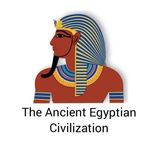Hurghada museum’s centerpiece is the painted limestone statue of Meritamun, the daughter of Ramses II.
The royal figure, whose title was also “Player of the sistrum of Mut and the Menat of Hathor,” wears lavish jewelry, including a crown featuring cobras with sun disks on their heads, as well as golden earrings and an intricate collar of beads.
This masterpiece showcases the high position of royal women in the New Kingdom from Dynasty 19 (c. 1295–1186 BC).
The royal figure, whose title was also “Player of the sistrum of Mut and the Menat of Hathor,” wears lavish jewelry, including a crown featuring cobras with sun disks on their heads, as well as golden earrings and an intricate collar of beads.
This masterpiece showcases the high position of royal women in the New Kingdom from Dynasty 19 (c. 1295–1186 BC).
The ancient Egyptians took inspiration from nature and their surroundings to create their language, which was written using signs and symbols depicting humans, animals, birds, plants, and other signs.
Join our celebrations this month by learning about these symbols through our daily posts, where we will introduce their meaning, pronunciation, and use in our "Ancient Egyptian Language" campaign.
This campaign is part of our “200 Years of Egyptology” celebrations, marking the bicentenary of the decipherment of the ancient Egyptian writing and the birth of Egyptology as a scientific field!
The campaign also includes "Learn About the Treasure in Your Governorate", highlighting the most important artifacts discovered in each Egyptian governorate.
Join our celebrations this month by learning about these symbols through our daily posts, where we will introduce their meaning, pronunciation, and use in our "Ancient Egyptian Language" campaign.
This campaign is part of our “200 Years of Egyptology” celebrations, marking the bicentenary of the decipherment of the ancient Egyptian writing and the birth of Egyptology as a scientific field!
The campaign also includes "Learn About the Treasure in Your Governorate", highlighting the most important artifacts discovered in each Egyptian governorate.
This sign represents an offering table that was presented to the deceased in ancient Egypt, consisting of a mat topped with loaves of bread. Various types of food and drink were offered to the dead by their relatives on these tables.
The sign has 3 sound components and is pronounced "he/te/p”. It has many meanings, including sacrifice, satisfy, & peace.
Hetep was used as part of various royal names, including "Amun-hetep" meaning "Amun is satisfied", the most famous name among Dynasty 18 kings.
This image shows offering bearers from the mortuary temple of Sahure.
The sign has 3 sound components and is pronounced "he/te/p”. It has many meanings, including sacrifice, satisfy, & peace.
Hetep was used as part of various royal names, including "Amun-hetep" meaning "Amun is satisfied", the most famous name among Dynasty 18 kings.
This image shows offering bearers from the mortuary temple of Sahure.
Akhenaten and the origins of Monotheism
By James K. Hoffmeier
https://t.me/c/1129099796/58169
https://t.me/c/1129099796/58170
Source: https://t.me/+Q0yyFJcN9dSiZC0Q
By James K. Hoffmeier
https://t.me/c/1129099796/58169
https://t.me/c/1129099796/58170
Source: https://t.me/+Q0yyFJcN9dSiZC0Q
Telegram
Egyptology and Archaeology
This channel helps all students looking for scientific books specialized in Egyptology for free.
-----------------------------------
في حالة عدم الموافقة على نشر اي كتاب تم نشرة يمكنكم مراسلتنا وطلب الحذف👇
@Alhamdany122
--------------------------------
-----------------------------------
في حالة عدم الموافقة على نشر اي كتاب تم نشرة يمكنكم مراسلتنا وطلب الحذف👇
@Alhamdany122
--------------------------------
Discovered in 1918 in Tell Atrib in Qalyoubiya and dating to the Ptolemaic Period, the black basalt statue of ‘Djedhor’ is known for the 'magic texts' that cover almost all of its surface area.
The figure of Djedhor is sculpted along the lines of a block statue. Before him is the stela of the child-deity Horus standing on two crocodiles, while holding other animals in his hands.
The basin placed at the feet served to collect the water that, after having wet the stela, would be believed to have magical powers!
The figure of Djedhor is sculpted along the lines of a block statue. Before him is the stela of the child-deity Horus standing on two crocodiles, while holding other animals in his hands.
The basin placed at the feet served to collect the water that, after having wet the stela, would be believed to have magical powers!
Did you know that the “sa” sign represents the world's first life jacket model? It was worn by fishermen and sailors in ancient Egypt to protect them from drowning.
Fittingly, it means protection, although it could also be used in other ancient Egyptian words referring to a magician, group of workmen, and sailors.
This sign would be included in a formula meant to protect the king which would read “sa-ankh-was” meaning “protection, life and power.”
Here, an older boat man is kneeling on his boat, wearing a sa-like bandoleer.
Fittingly, it means protection, although it could also be used in other ancient Egyptian words referring to a magician, group of workmen, and sailors.
This sign would be included in a formula meant to protect the king which would read “sa-ankh-was” meaning “protection, life and power.”
Here, an older boat man is kneeling on his boat, wearing a sa-like bandoleer.
